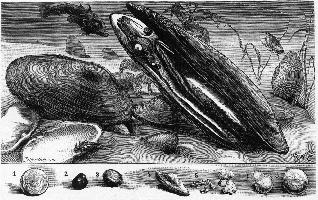
Statut de conservation
| Menacé |
Description de l'animal
The Freshwater Pearl Mussel (Margaritifera margaritifera) is a fascinating and ecologically significant species that thrives in the clean, cold waters of freshwater rivers and streams across the Northern Hemisphere, including parts of Europe, North America, and Russia. This species is renowned not only for its ecological role but also for its historical and cultural significance, particularly due to its ability to produce pearls.Physically, the Freshwater Pearl Mussel has a thick, elongated shell that can grow up to 15 centimeters (about 6 inches) in length, though sizes vary. The shell is typically dark brown or black on the outer surface, providing camouflage against the riverbed, while the interior is smooth and iridescent, a characteristic that contributes to the mussel's pearl-producing ability. The shell's durability and the mussel's relatively long lifespan, which can exceed 100 years in optimal conditions, make this species a living record of its freshwater habitat's health.
The life cycle of Margaritifera margaritifera is complex and closely tied to the presence of specific species of fish, particularly salmon and trout. The mussel's larvae, known as glochidia, must attach to the gills of a host fish to develop. This parasitic stage is critical for the mussel's survival and dispersal. After several weeks, the glochidia transform into juvenile mussels and detach from the host, settling into the riverbed where they burrow into the substrate. This unique lifecycle contributes to the mussel's vulnerability, as it depends on healthy populations of specific fish species and clean, oxygen-rich waters.
Ecologically, Freshwater Pearl Mussels play a crucial role in their aquatic environments. They are filter feeders, drawing in water to extract nutrients and, in the process, helping to clarify and purify the water. This filtration ability can significantly impact water quality and the health of other species within their habitat. However, despite their ecological importance, Freshwater Pearl Mussels face numerous threats. Pollution, habitat destruction, water abstraction, and the decline of host fish populations have led to a dramatic decrease in mussel numbers. Consequently, Margaritifera margaritifera is now considered endangered or critically endangered in many parts of its range.
Conservation efforts are underway to protect and restore Freshwater Pearl Mussel populations. These efforts include improving water quality, restoring river habitats, protecting remaining populations, and breeding programs aimed at bolstering mussel numbers. The conservation of this species is not only vital for maintaining biodiversity but also for preserving the health of freshwater ecosystems.
In conclusion, the Freshwater Pearl Mussel is a remarkable species that embodies the intricate connections within aquatic ecosystems. Its survival is closely linked to the health of its environment, making it a sentinel species for freshwater conservation. Protecting and restoring Margaritifera margaritifera populations is not only critical for the species' survival but also for the broader ecological health of rivers and streams across its range.
Nouvelles photos d'animaux
Top 10 des animaux
- Dolphin gull (Leucophaeus scoresbii)
- Diana monkey (Cercopithecus diana)
- Moustached guenon (Cercopithecus cephus)
- Galápagos tortoise (Geochelone nigra complex)
- Russian tortoise (Testudo horsfieldii)
- Japanese macaque (Macaca fuscata)
- Stone loach (Barbatula barbatula)
- Greek tortoise (Testudo graeca)
- Common flying dragon (Draco volans)
- Colossal squid (Mesonychoteuthis hamiltoni)